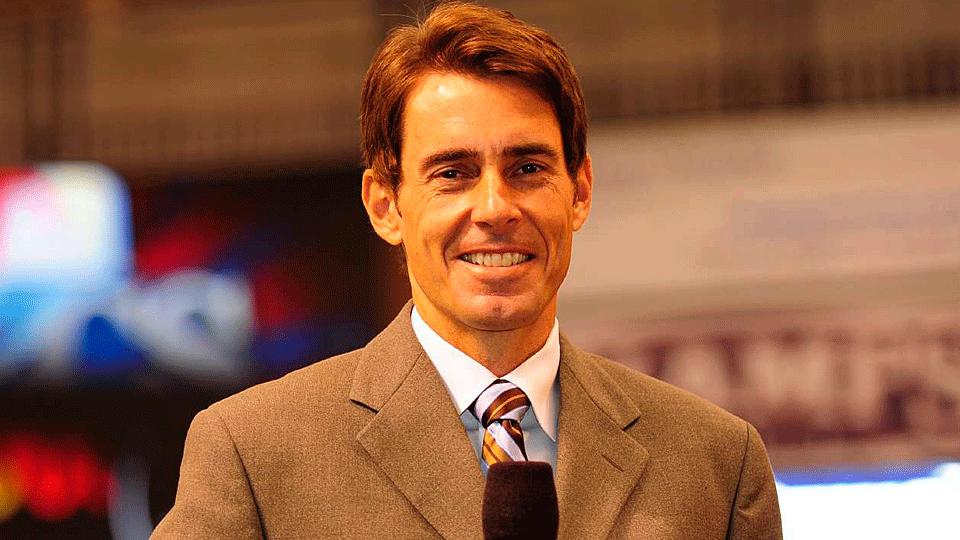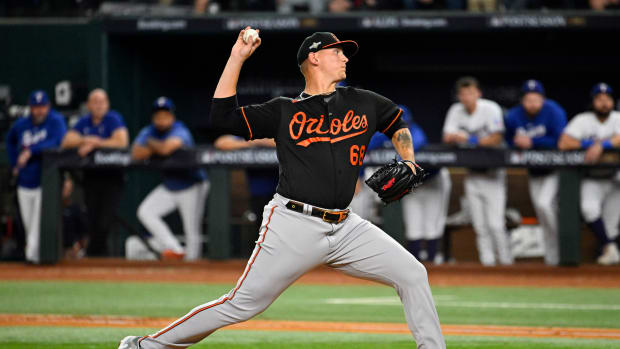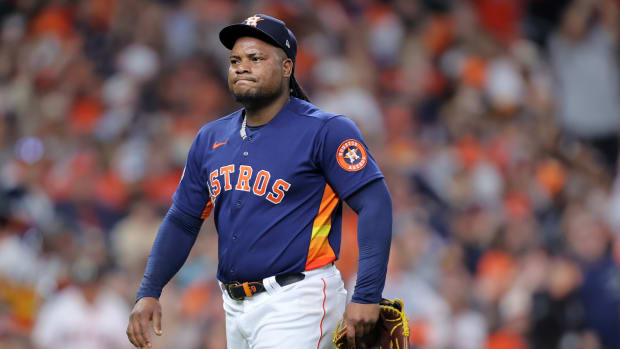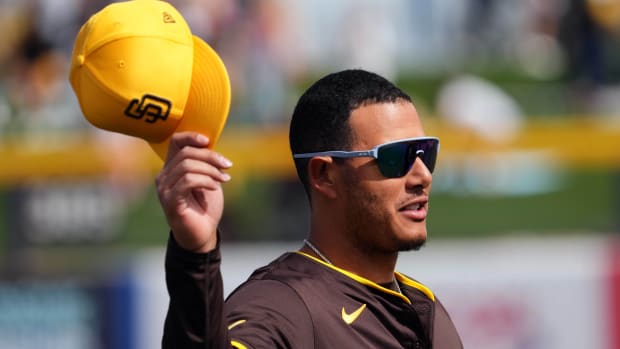SI 60 Q&A: How Tom Verducci blew the lid off baseball's Steroid Era
In honor of Sports Illustrated's 60th anniversary, SI.com is republishing, in full, 60 of the best stories to ever appear in the magazine. Today's selection was "Totally Juiced," by Tom Verducci, which first appeared in the June 3, 2002 issue. I spoke to Verducci about how he found a former National League MVP to discuss steroid use on the record, the pressure he felt to get the story and how it has changed the sport forever.
SI: This might be the most impactful story in the history of Sports Illustrated, in that it blew the lid off the Steroid Era in baseball once and for all. How do you assess the impact the story had?
VERDUCCI: It helped change baseball, I don’t think there’s any doubt about that. In February of that year, while negotiating a new collective bargaining agreement, the owners had presented to the players a proposal that included drug testing for performance enhancing drugs and it was summarily dismissed. There was no discussion about it. The owners didn’t push it, but the players made it clear they weren’t going to talk about it.
A few months after the story, the players agreed to a form of drug testing for the first time in their labor history. There’s no doubt that the story made the topic of PEDs a front burner issue because it was a topic that neither side could ignore anymore.
Read each story and Q&A in the SI 60 series
SI: How did you get this story?
VERDUCCI: People had been writing about steroids tangentially for years. I remember for the cover story of our 1998 baseball preview issue sitting down with Mark McGwire at his house in Orange County, Calif., and asking him point blank if he used steroids. He denied it. So the subject was out there but how do you get anybody to talk about this deep, dark secret with their names attached to it publicly?
I had gradually seen the game change in terms of players’ body types in the late 1990s and early 2000s. The 2001 season was the first time I’d had players who were clean coming up to me and complaining how unfair the game was.
The Left Arm of God: Sandy Koufax was more than just a perfect pitcher
SI: Were those unsolicited complaints?
VERDUCCI: Yeah, or maybe just in the course of talking about another player and the way the season was going. And they were all off the record. But I wasn’t going up to them and asking about it. We would be in conversation about something else. They’d say, “Now I feel like I’m at a competitive disadvantage.” They felt if they were playing the game clean they were at a disadvantage.
To me that was the tipping point. In spring training of 2002 we at SI, the baseball writers and editors, had either a conference call or a meeting to talk about story ideas for the season. At that time I said, “The story of the season will be how much steroid use is going on in baseball. And we better be the ones to write this story.”
They put that on the docket and said, “See what you can find out about it,” and so I dd. The trick was, How do you get people to talk about the unmentionable? That’s what steroids were at the time. I couldn’t write a story full of anonymous quotes and speculation. That had been done before.
I started reporting that story and it wasn’t hard to get guys to talk off the record. The big break, obviously, was getting Ken Caminiti.
SI: How did you get him?
VERDUCCI: That was when we had the old CNN/SI [television] days. A producer at CNN who had done an interview with Caminiti – and I’m not sure when it was -- mentioned that he had spoken, not about himself, but somewhat openly about steroids and was at ease with the subject. She said that maybe he’d be someone I’d want to talk to.
I knew him from his playing days, so I called him up at his home in Houston. There was no hesitation from him. He said, “Come one down,” so I got on a plane and went to his house. We sat in his garage -- he really liked to work on cars, he put a lot of cars into car shows and had a big multi-car garage -- in a couple lawn chairs and talked for hours. He was completely unflinching. At no point, not even off the record, did he mention anybody else’s name. At no point did he try to cast any blame on anyone else.
SI 60 Q&A: Tom Verducci on Sandy Koufax and 'The Left Arm Of God'
SI: He had gone from a player with some pop in his bat to one who hit 26 home runs, then a career high, at age 32 in 1995, and followed it up with 40 in 1996, when he won the NL MVP award. Were you at all suspicious of how we had done that while it was happening?
VERDUCCI: I certainly had suspicions just based on the arc of his career and what was going on in baseball at that time anyway. I figured he knew a lot about the subject.
SI: Why do you think he agreed to talk to you?
VERDUCCI: That’s a great question. I think it had to do with some of the substance abuse problems he had and being honest with who he was at the time. He was trying to overcome so many other demons in his life that he wanted to speak openly about anything. He emphasized several times that he had no regrets about the decision that he made. I never got the sense he was trying to hide anything, in fact he said multiple times “I’ve got nothing to hide. I want to be a good father and provide for my daughters and this is what I want to do.”
That night we went out to dinner together at a place that was more like a diner than a restaurant -- all the waitresses and cooks knew him and he ordered the usual, which was an egg white omelette. He said, “This is a pretty big deal huh?” I said, “Yeah, I’m sure it will be a big deal.”
SI: What was the reaction like toward Caminiti?
VERDUCCI: From what I heard there was a lot of backlash to Ken from the union because they didn’t want to deal with the issue. That was predictable, I think.
What Is The Citadel? For some athletes, it was a place of nightmares
SI: Once you talked to him did you feel like you had to write it immediately, or was there a lot more work to do?
VERDUCCI: At that point I was probably 6 to 8 weeks into reporting out the story. I already had a lot in my notebook, again some of it anonymously sourced. I thought I was making decent headway, but I knew once I had a former MVP on the record I had a story that you wanted to get. I’m not sure how soon after that I wrote the story, but it wasn’t immediate.
It was a sensitive story, so it went through a bunch of fact checking and there were other sidebars associated with that story, so there were still a lot of things to pull together. It definitely wasn’t the kind of story you wanted to rush. You were going to get one chance to write it.
SI: Twitter obviously wasn’t around at the time, but SI’s website certainly was. How much did you have to consider simply filing something right away for immediate consumption online versus saving the entire thing for the magazine?
VERDUCCI: There’s no doubt that as fast as things were moving even in 2002 they’re much faster today. My guess is it still would have been a story to hold for the magazine and to make sure that it was for the highest quality and completeness. I don’t think we would have rushed to get it out there.
SI: Were you at all worried that he would talk to someone else?
VERDUCCI: I was pretty comfortable that he hadn’t talked to anyone else and I didn’t think anyone else was there beating down his door.
SI: Did you ask him not to talk to anyone else?
VERDUCCI: I didn’t say that, but my instinct was that I wasn’t dealing with a highly competitive situation that had to be rushed. My biggest worry at the time was Jose Canseco because he was making some noise about writing a book. I could have the timeline wrong but he was talking about how we was blackballed from the game and couldn’t find a job, but there was still nothing out there concrete from Canseco or anybody else. During the reporting of my story he started making noise about writing a book and having some things to say, so I was aware of that from a competitive standpoint.
SI 60 Q&A: And on the eighth day, Richard Hoffer finally got Barry Bonds to speak to him
SI: Did you reach out to Canseco?
VERDUCCI: I did but I didn’t get anywhere. Looking back on it now he had designs on a book so he wasn’t going to give his story away for free.
SI: Did you alert Major League Baseball and the union that this story was coming, and if so, did you tell them about Caminiti?
VERDUCCI: As far as Caminiti’s admission I did keep a lid on that. I figured that was something that needed to be kept quiet. The other things we let the union and the commissioner’s office know that there was a story coming. I didn’t get the sense that anybody thought it would be as big as it was. Their reaction was more that, This is overblown, it’s not really a big problem. Whether people didn’t know or wanted to downplay how big it actually was, I’m sure people thought [the story] would be more speculative than it was.
SI: Did you realize how big the story would be?
VERDUCCI: No. I knew it was an important story but I didn’t realize until it was published how big it would be. I didn’t realize the full impact until it got out and then of course you get inundated with interview requests from everything from the Today show to sports radio stations. It was one of those stories that would transcend sports.
There’s no doubt that Caminiti’s admission was a gamechanger in waking people up to the problem. It still took people in uniform time to come around. When he said that half the players in baseball were using PEDs he wasn’t trying to be scientific it was just his observation, but it spoke to how prevalent they were.
People had a hard time grasping that idea. They thought it was a handful of guys experimenting with this stuff. People didn’t associate anabolic gains with the sport of baseball. It turns out he was in the right ballpark. Even as he said that people were saying that he was full of it. I didn’t understand that. Looking back now I do, though, because they didn’t want their image of the game broken and people didn’t want their bubble burst. He was a guy who didn’t have an agenda.
SI: What percentage of players at that time would you have suspected were using steroids?
VERDUCCI: I probably said it was around half, maybe less than half. The clean players were saying, “Now I feel outnumbered.” When [Caminiti] said that [50 percent] my jaw did not drop. It didn’t sound shocking.
SI: What was the reaction to the story toward you?
VERDUCCI: I don’t recall anybody being upset at me personally but they were upset at me writing the story. Dusty Baker called Caminiti a snitch. There was a lot of that going on, Hey this game has been good to you, why would you say those kinds of things? It’s an age-old story: attack the messenger. It’s hilarious, well not hilarious, but peculiar to look back now and see some of the responses to players and Caminiti and that story: Mike Stanton, Jason Giambi guys who turned out later on were in the Mitchell Report or identified as steroid users, they wanted to keep that secret.
SI: Where did you think the story would go next?
VERDUCCI: I wasn’t expecting that more guys would come out and admit it, but I was expecting that this was about to really blow open. We certainly were going to find out more than one player used them, but by what means I wasn’t sure. But there were literally hundreds using steroids.
Just two months later the union agreed to undergo drug testing. You can say that survey testing was a joke and that it was their way of continuing to avoid the issue or that it amounted to an announced test, but the fact is that for the players -- after being so stringently opposed to steroid testing because of quote unquote “personal rights violations” -- to change their stance on that that was a huge surprise.
SI: Was there any concern or hesitation about publishing the story?
VERDUCCI: Always with a story like that there’s a high degree of vetting the story and making sure it’s absolutely dead on, but I don’t recall any hesitation that “We have to be super, super careful about even publishing a story like this.” If you had a player who was anonymously saying those things then maybe, but this was on the record.
SI: How do you personally interpret the change you brought to the game by doing this story?
VERDUCCI: It wasn’t anything I set out to do in terms of affecting a change, but anytime you do a story that has an impact beyond that day’s headlines and in what I regard as a very positive direction there has to be a certain amount of pride. I’m glad that it wasn’t just a one-day headline. It wasn’t just here and gone.
I do think that people in the media get a bad rap. I covered baseball throughout that era, and I saw the way things were changing. But there’s a big difference between what you suspect and what you know. There definitely was not the kind of recklessness to start throwing names and suspicions out there, because privately a lot of us heard [the rumors]. It’s not like we were avoiding the topic. It was a very difficult thing to write about.
SI: Did it change how you viewed the game at that time?
VERDUCCI: That was probably true with Barry Bonds. It was hard to admire or even enjoy what he was doing, but that’s farther down the road. You go up to McGwire in January of 1998 and you’re face-to-face with him and he’s denying using them. It wasn’t like we were avoiding the topic. The players were avoiding the topic. They wanted to keep their dirty little secret a secret. The idea that the media was protecting the players is just a fallacy. When I had attributable information on the record I went with it.
SI: Did you talk about everything with Caminiti after the story came out?
VERDUCCI: I never really discussed the impact with him. I think I ran across him one other time and just casually said hello. We didn’t talk about it.
SI: He died in 2004, three years before the Mitchell Report and long before tough PED penalties were put into place. Do you think he had a sense of the impact of what he did?
VERDUCCI: I hope he did but again I’m sure he got a lot of negative feedback from the player’s association. I don’t think he lived long enough for the public to understand how important it was what he did. I believe it was Ann Killion of the San FranciscoChronicle [a former SI.com contributor] who wanted to vote for him for the Hall of Fame because he was an agent of change. While I didn’t vote for him, I understand the sentiment of somebody who did.
SI: Does the fact that an entire era of baseball is now called into question in part because of this story concern you at all?
VERDUCCI: It doesn’t bother me. My responsibility is to get the story right. I can’t predict or be concerned with the consequences.
Eventually the story was going to be written whether it was Caminiti or Canseco or someone else. There were too many people making the same decision that those guys did.




































